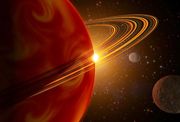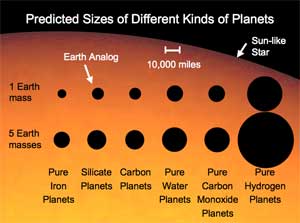Gas giant
.jpg)
A gas giant (sometimes also known as a Jovian planet after the planet Jupiter, or giant planet) is a large planet that is not primarily composed of rock or other solid matter. There are four gas giants in our Solar System: Jupiter, Saturn, Uranus, and Neptune. Many extrasolar gas giants have been identified orbiting other stars.
Planets above 10 Earth masses are termed giant planets[1]. Below 10 Earth masses they are called super earths or, sometimes probably more accurately for the higher mass examples, "Gas Dwarfs" eg. as suggested by MIT Professor Sara Seager for Gliese 581c using a model where that exoplanet was mostly composed of hydrogen and helium.
Objects above 13 Jupiter masses are called brown dwarfs and these occupy the mass range between that of large gas giant planets and the lowest mass stars.
Contents |
Description
A gas giant is a massive planet with a thick atmosphere and a solid core. The "traditional" gas giants, Jupiter and Saturn, are composed primarily of hydrogen and helium. Uranus and Neptune are sometimes called ice giants, as they are mostly composed of water, ammonia, and methane ices. Among extrasolar planets, Hot Jupiters are gas giants that orbit very close to their stars and thus have a very high surface temperature. Hot Jupiters are currently the most common form of extrasolar planet known, perhaps due to the relative ease of detecting them.
Gas giants are commonly said to lack solid surfaces, but it is closer to the truth to say that they lack surfaces altogether since the gases that make them up simply become thinner and thinner with increasing distance from the planets' centers, eventually becoming indistinguishable from the interstellar medium. Therefore landing on a gas giant may or may not be possible, depending on the size and composition of its core.
Belt-zone circulation
The bands seen in the Jovian atmosphere are due to counter-circulating streams of material called zones and belts, encircling the planet parallel to its equator. The zones are the lighter bands, and are at higher altitudes in the atmosphere. They have an internal updraft, and are high-pressure regions. The belts are the darker bands. They are lower in the atmosphere, and have an internal downdraft. They are low-pressure regions. These structures are somewhat analogous to high- an low-pressure cells in Earth's atmosphere, but they have a very different structure — latitudinal bands that circle the entire planet, as opposed to small confined cells of pressure. This appears to be a result of the rapid rotation and underlying symmetry of the planet. There are no oceans or landmasses to cause local heating, and the rotation speed is much faster than it is on Earth. There are smaller structures as well; spots of different sizes and colors. On Jupiter, the most noticeable of these features is the Great Red Spot, which has been present for at least 300 years These structures are huge storms. Some such spots are thunderheads as well.

Jupiter and Saturn
Jupiter and Saturn consist mostly of hydrogen and helium, with heavier elements making up between 3 and 13 percent of the mass.[2] Their structures are thought to consist of an outer layer of molecular hydrogen, surrounding a layer of liquid metallic hydrogen, with a probable rocky core. The outermost portion of the hydrogen atmosphere is characterized by many layers of visible clouds that are mostly composed of water and ammonia. The metallic hydrogen layer makes up the bulk of each planet, and is described as "metallic" because the great pressure turns hydrogen into an electrical conductor. The core is thought to consist of heavier elements at such high temperatures (20,000 K) and pressures that their properties are poorly understood.[2]
Uranus and Neptune
Uranus and Neptune have distinctly different interior compositions from Jupiter and Saturn. Models of their interior begin with a hydrogen-rich atmosphere that extends from the cloud-tops down to about 85% of Neptune's radius and 80% of Uranus'. Below this point is predominantly "icy", composed of water, methane and ammonia. There is also some rock and gas but various proportions of ice/rock/gas could mimic pure ice so the exact proportions are unknown.[3]
Very hazy atmosphere layers with a small amount of methane gives them aquamarine colors such as baby blue and ultramarine colors respectively. Both have magnetic fields that are sharply inclined to their axes of rotation.
Unlike the other gas giants, Uranus has an extreme tilt that causes its seasons to be severely pronounced.
Extrasolar gas giants

Because of the limited techniques currently available to detect extrasolar planets, many of those found to date have been of a size associated, in our solar system, with gas giants. Because these large planets are inferred to share more in common with Jupiter than with the other gas giant planets some have claimed that "Jovian planet" is a more accurate term for them. Many of the extrasolar planets are much closer to their parent stars and hence much hotter than gas giants in the solar system, making it possible that some of those planets are a type not observed in our solar system. Considering the relative abundances of the elements in the universe (approximately 98% hydrogen and helium) it would be surprising to find a predominantly rocky planet more massive than Jupiter. On the other hand previous models of planetary system formation suggested that gas giants would be inhibited from forming as close to their stars as have many of the new planets that have been observed.
Smaller gas planets

Although the words "gas" and "giant" are often combined, hydrogen planets need not be as large as the familiar gas giants from our solar system. However smaller gas planets and planets closer to their star will lose atmospheric mass more quickly via hydrodynamic escape than larger planets or planets farther out.[4][5]
Terminology
The term gas giant was coined in 1952 by the science fiction writer James Blish. Arguably it is something of a misnomer, since throughout most of the volume of these planets all the components (other than solid materials in the core) are above the critical point and therefore there is no distinction between liquids and gases. Fluid planet would be a more accurate term. Jupiter is an exceptional case, having metallic hydrogen near the center, but much of its volume is hydrogen, helium and traces of other gases above their critical points. The observable atmospheres of any of these planets (at less than unit optical depth) are quite thin compared to the planetary radii, only extending perhaps one percent of the way to the center. Thus the observable portions are gaseous (in contrast to Mars and Earth, which have gaseous atmospheres through which the crust may be seen).
The rather misleading term has caught on because planetary scientists typically use "rock", "gas", and "ice" as shorthands for classes of elements and compounds commonly found as planetary constituents, irrespective of what phase they appear in. In the outer solar system, hydrogen and helium are "gases"; water, methane, and ammonia are "ices"; and silicates and metals are rock. When deep planetary interiors are considered, it may not be far off to say that, by "ice" astronomers mean oxygen and carbon, by "rock" they mean silicon, and by "gas" they mean hydrogen and helium.
The alternative term Jovian planet refers to the Roman god Jupiter—a form of which is Jovis, hence Jovian—and was intended to indicate that all of these planets were similar to Jupiter. However, the many ways in which Uranus and Neptune differ from Jupiter and Saturn have led some to use the term only for the latter two.
With this terminology in mind, some astronomers are starting to refer to Uranus and Neptune as "ice giants" to indicate the apparent predominance of the "ices" (in liquid form) in their interior composition.[6]
See also
- Chthonian planet
- Hot Jupiter
- Planetary system
- Solar System
- Sudarsky extrasolar planet classification
- Terrestrial planet
Notes
- ↑ Page 20 of The quest for very low-mass planets, M Mayor, S Udry - Physica Scripta, 2008
- ↑ 2.0 2.1 The Interior of Jupiter, Guillot et al., in Jupiter: The Planet, Satellites and Magnetosphere, Bagenal et al., editors, Cambridge University Press, 2004
- ↑ L. McFadden, P. Weissman, T. Johnson (2007). Encyclopedia of the Solar System (2nd ed.). Academic Press. ISBN 978-0-12-088589-3.
- ↑ TRANSONIC HYDRODYNAMIC ESCAPE OF HYDROGEN FROM EXTRASOLAR PLANETARY ATMOSPHERES, Feng Tian, Owen B. Toon, Alexander A. Pavlov, H. De Sterck, The Astrophysical Journal, 621:1049–1060, 2005 March 10
- ↑ Mass-radius relationships for exoplanets, Damian C. Swift, Jon Eggert, Damien G. Hicks, Sebastien Hamel, Kyle Caspersen, Eric Schwegler, and Gilbert W. Collins
- ↑ Jack J. Lissauer, David J. Stevenson (2006). "Formation of Giant Planets" (PDF). NASA Ames Research Center; California Institute of Technology. http://www.astrosmo.unam.mx/esp/PPV/7%20%20PLANET%20FORMATION%20AND%20EXTRASOLAR%20PLANETS/sec7-1.pdf. Retrieved 2006-01-16.
References
- Episode "Giants" on The Science Channel TV show Planets
- SPACE.com: Q&A: The IAU's Proposed Planet Definition 16 August 2006 2:00 am ET
- BBC News: Q&A New planets proposal Wednesday, 16 August 2006, 13:36 GMT 14:36 UK
External links
- SPACE.com: Q&A: The IAU's Proposed Planet Definition 16 August 2006 2:00 am ET
- BBC News: Q&A New planets proposal Wednesday, 16 August 2006, 13:36 GMT 14:36 UK
- Gas Giants in Science Fiction: List
|
|||||||||||||||||
|
||||||||||||||||||||||||||||||||||||